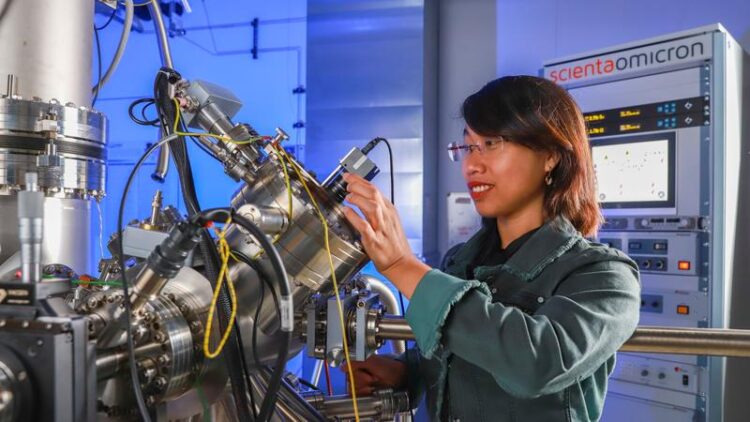Tracking Topological Conditions in Graphene

The scanning tunnel microscope’s measurements were made in the Solid Surfaces Analysis lab at Chemnitz University of Technology by researchers including doctoral student Thi Thuy Nhung Nguyen.
Jacob Müller / TU Chemnitz
International research team shows how carbon-based nanostructures can get a new functionality – research results are presented in the magazine Nano Letters.
Scientists have already been able to demonstrate that graphene nanostructures can be generated by annealing of a nanostructured silicon carbide crystal for a few years. “These two-dimensional, spatially strongly restricted carbon bands exhibit a vanishingly small electrical resistance even at room temperature. They are thus ballistic,” explains Prof. Dr. Christoph Tegenkamp, Head of the Professorship of Solid Surfaces Analysis at Chemnitz University of Technology.
Something similar does not happen, for example, with an expanded and perfectly two-dimensional layer of graphene. Physicists at Chemnitz University of Technology, working together with researchers from Eindhoven University of Technology (Netherlands), the Max Planck Institute in Stuttgart, and the MAX IV Laboratory in Lund (Sweden), succeeded in a better understanding of this quantum effect.
“We could verify the exact structure of these so-called nanoribbons for the first time with help of an extremely high-resolution transmission electron microscope,” reports doctoral student Markus Gruschwitz from the Professorship of Solid Surfaces Analysis. Thi Thuy Nhung Nguyen, who is also completing her doctoral studies in this area, adds, “Together with measurements from the scanning tunneling microscope, the particular quantum state of this system could now be localized and spectroscopized with high resolution.”
It is important for a theoretical description of the electronic structure that the edge of the graphene nanostructure has a bond to the substrate and the bending induced by this causes a so-called strain effect. Using this model, it was also possible to explain the spin polarization of the migrating electrons. “This bending of the graphene structure has an effect similar to that otherwise found only in materials with strong spin-orbit coupling. Interestingly, graphene itself has a vanishingly small spin-orbit interaction,” Tegenkamp says.
The research results were presented in the current issue of “Nano Letters”. The authors of the study are certain that the exploitation of defined curvatures will give rise to new functionalities in supposedly trivial structures and materials, and that the research field of straintronics will become further established.
Wissenschaftliche Ansprechpartner:
Prof. Dr. Christoph Tegenkamp, phone: 0371 531-33103, e-mail: christoph.tegenkamp@physik.tu-chemnitz.de
Originalpublikation:
Thi Thuy Nhung Nguyen et al. Topological Surface State in Epitaxial Zigzag Graphene Nanoribbons. Nano Lett. 2021, 21, 7, 2876–2882. DOI: https://pubs.acs.org/doi/10.1021/acs.nanolett.0c05013
Media Contact
All latest news from the category: Physics and Astronomy
This area deals with the fundamental laws and building blocks of nature and how they interact, the properties and the behavior of matter, and research into space and time and their structures.
innovations-report provides in-depth reports and articles on subjects such as astrophysics, laser technologies, nuclear, quantum, particle and solid-state physics, nanotechnologies, planetary research and findings (Mars, Venus) and developments related to the Hubble Telescope.
Newest articles

Innovative 3D printed scaffolds offer new hope for bone healing
Researchers at the Institute for Bioengineering of Catalonia have developed novel 3D printed PLA-CaP scaffolds that promote blood vessel formation, ensuring better healing and regeneration of bone tissue. Bone is…

The surprising role of gut infection in Alzheimer’s disease
ASU- and Banner Alzheimer’s Institute-led study implicates link between a common virus and the disease, which travels from the gut to the brain and may be a target for antiviral…

Molecular gardening: New enzymes discovered for protein modification pruning
How deubiquitinases USP53 and USP54 cleave long polyubiquitin chains and how the former is linked to liver disease in children. Deubiquitinases (DUBs) are enzymes used by cells to trim protein…


